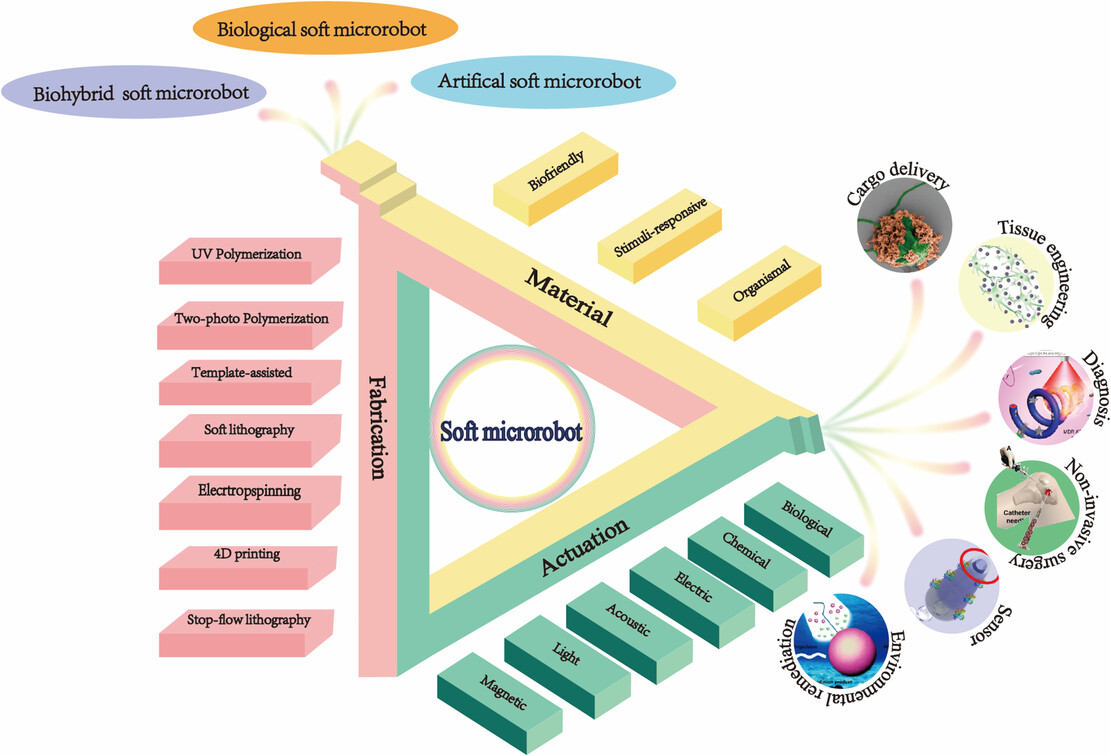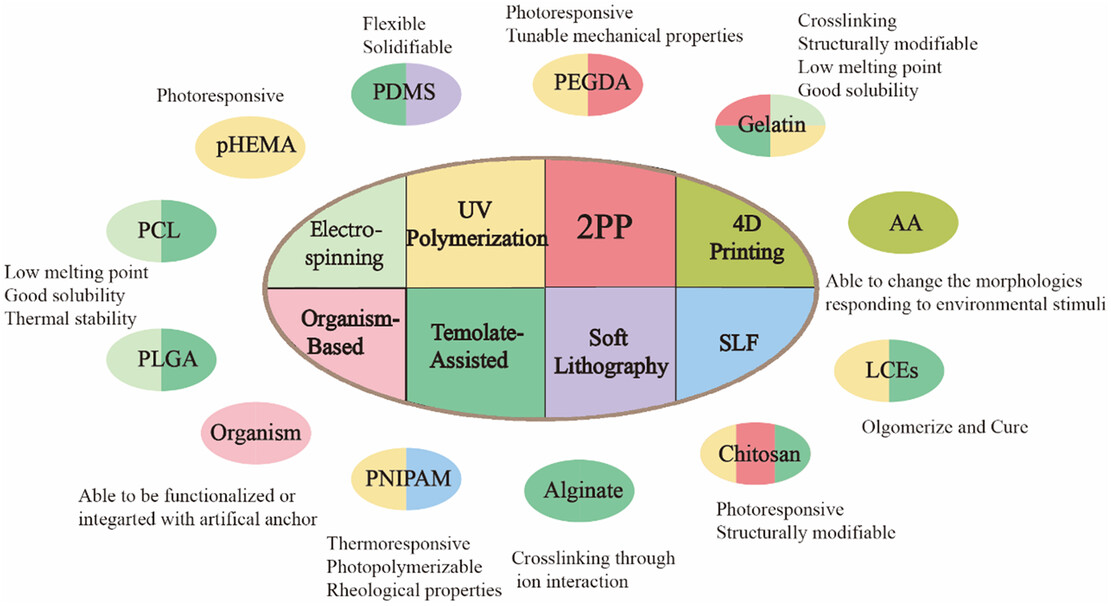| Dec 04, 2023 | |
State of the art in soft microrobotics materials, fabrication and actuation |
|
| (Nanowerk News) The concept of microrobots has evolved significantly since physicist Richard Feynman first envisioned the potential of tiny machines in the 1950s. The early prototypes of microrobots, with their rigid bodies, faced substantial challenges in navigating complex biological and industrial environments without causing damage. This led to a pivotal shift towards developing soft, deformable microrobots using adaptive materials that are more compatible with their target environments. | |
| In recent years, the field of soft microrobotics has seen rapid innovation, particularly in the areas known as "the three cornerstones of soft microrobots" – materials, fabrication, and actuation. These developments have been driven by interdisciplinary collaboration in microengineering, materials science, and robotics, moving closer to realizing Feynman's vision. | |
| A recent review article in Advanced Intelligent Systems ("A Review of Soft Microrobots: Material, Fabrication, and Actuation") delves into the latest advancements in soft microrobotics, focusing on their material composition, fabrication methods, and actuation techniques, which collectively shape their functionality and effectiveness. | |
 |
|
| Three cornerstones (material, fabrication, and actuation), categories, and applications of soft microrobots. (Reprinted with permission from Wiley-VCH Verlag) (click on image to enlarge) | |
Materials: The Foundation of Soft Microrobotics |
|
| The breakthrough in soft microrobotics largely hinges on the development of soft biomaterials that possess ideal properties like biodegradability, tunable elasticity, and responsiveness to environmental stimuli like light, temperature, or chemicals. These materials include advanced polymers and hydrogels that can change shape or behavior in response to specific conditions, making them ideal for complex tasks in delicate environments. | |
Fabrication Techniques: Crafting Sophistication |
|
| Advances in fabrication techniques such as two-photon lithography have enabled the transition from flat, single-layer microrobots to fully 3D mobile structures. These sophisticated fabrication methods have facilitated the creation of microrobots with intricate features, including porous internal cargo bays for drug delivery, articulated limbs for precise movements, and even helical propellers for swimming through viscous media. | |
 |
|
| Commonly used collocation between materials and fabrication methods. (Reprinted with permission from Wiley-VCH Verlag) | |
Actuation and Control: Bringing Microrobots to Life |
|
| The actuation and control of soft microrobots have seen significant improvements, with techniques like rotating magnetic fields enabling remote steering of devices in fluid environments reminiscent of bacterial movement. (Hydrogels with near-infrared actuation capabilities have also been developed, allowing for precise control over the microrobots' shape and movement. | |
| Many newly created soft biomaterials now possess ideal properties from biodegradability – slowly breaking down inside bodies – to tunable elasticity and shape-morphing behaviors responsive to light, temperature or chemical stimuli. Two-photon lithography and other microscale manufacturing methods also facilitated the transition from flat single-layer microrobots toward fully 3D mobile architectures with never-before-seen complexity, including porous internal cargo bays, articulated limbs for grasping objects, and helical propellers to “swim” through viscous media. | |
| Creating such intricate polymer-based moving parts expanded soft microrobot capabilities exponentially while retaining a tiny submillimeter footprint. These hardware advancements paired with enhanced external guidance techniques to transport, reposition and track soft microrobots in real-time. Rotating magnetic fields can now remotely steer devices along trajectories reminiscent of bacteria inside dense bodily fluids and tissues. Custom-tailored hydrogels undergo “near-infrared actuation”, shriveling or stretching as desired when bathed in specific infrared wavelengths. | |
| With soft microrobot technologies maturing on multiple fronts, researchers proved remarkably adept at coordinating their function for solving complex problems. Biodegradable drug-loaded micromachines can now target diseased tissue, before releasing therapeutic payloads and safely dissolving. Other teams selectively bonded bacteria to microbeads creating biohybrid systems that leverage both synthetic and organic components working in unison. The applications encompass everything from micro-assembly of electronic components to scraping contaminants off aging valuables artifacts. | |
| However, some of the most exciting demonstrations involve visionary medical interventions. For example, scientist created synthetic microalgae-based microrobots that penetrate deeply into infected rabbit lung tissue while steadily releasing antibiotics customized against harmful bacteria detected through onboard peptide receptors. Within an hour, over 90% of the infection cleared versus less than 50% for directly injected antibacterial drugs. By adapting drug dispensing rates andfavoring self-powered penetration through delicate membranes separating airways, incredibly efficient pneumonia treatment became possible. The results promise to upend the global leading infectious cause of death. | |
| Other research formed microrobots into cellular microtools to actively aid sperm reproduction, gripping individual cells with impressive precision before releasing them. Additional projects explore self-powered environmental remediators tasked with locating and neutralizing toxins. One study created soft microrobots with embedded iron nanoparticles able to degrade potent water pollutants into harmless byproducts when exposed to visible light. The miniaturized machines’ small size allows them to permeate soil areas inaccessible to larger devices. | |
| Experts suggest the field nears a tipping point where living laboratories will soon graduate microrobots to regulated testing pipelines – first in animals, and later potentially within human volunteers. Though initially intended for short-term diagnostic or therapeutic applications, advances might one day produce multifunctional soft machines able to intimately monitor biomarkers and stimulate healing processes for weeks or longer. Further down the road, optimized soft microrobots could coordinate complex cellular microsurgeries or execute redundant tasks in swarms as biodegradable tools synthesizing new tissues or filtering environmental biohazards. | |
| In a novel approach, living organisms like sperm cells, red blood cells, bacteria, and neutrophils have been integrated into soft microrobots. These biohybrid microrobots combine the natural sensing and propulsion abilities of living organisms with the control and functionality provided by artificial components. This integration has proven effective for tasks like targeted drug delivery and navigating complex biological environments. | |
| Soft microrobots represent a significant leap forward in both medical and environmental applications. In medicine, they promise more localized and less invasive procedures, including targeted drug delivery, cell transplantation, noninvasive surgery, and diagnostic processes. In the environmental sector, they offer innovative solutions for remediation and monitoring. | |
| However, as applications grow more intricate, discussions remain open on several fronts – particularly standardizing safety requirements as microscale robotics transitions more intimately into healthcare and commercial settings. Researchers continue developing increasingly multifaceted and autonomous functionality while proactively ensuring ethical protocols guide testing. If successful, soft microrobotics promises to unlock new possibilities across nearly every technical discipline. Society must guarantee proprietary interests do not hamper equal access to what may profoundly impact human potential. |
| Source: Nanowerk (Note: Content may be edited for style and length) |
We curated a list with the (what we think) 10 best robotics and AI podcasts – check them out!
Also check out our Smartworlder section with articles on smart tech, AI and more.

